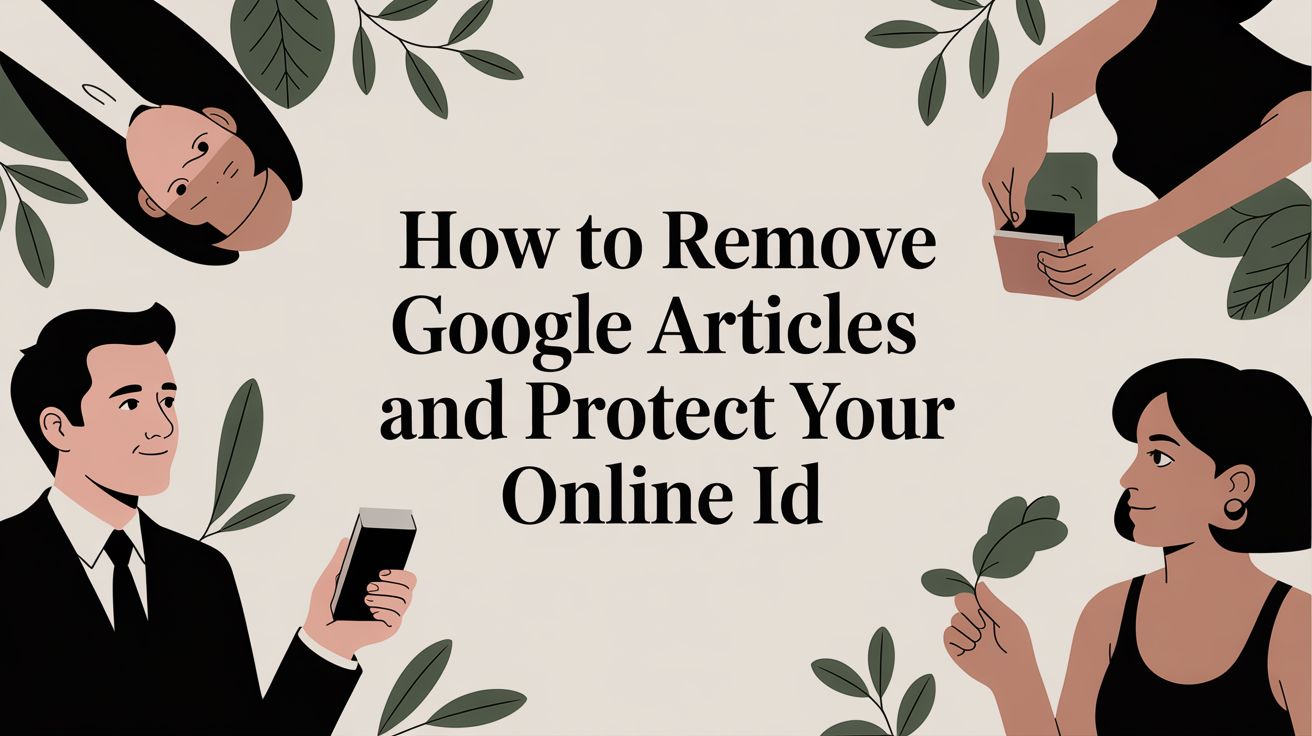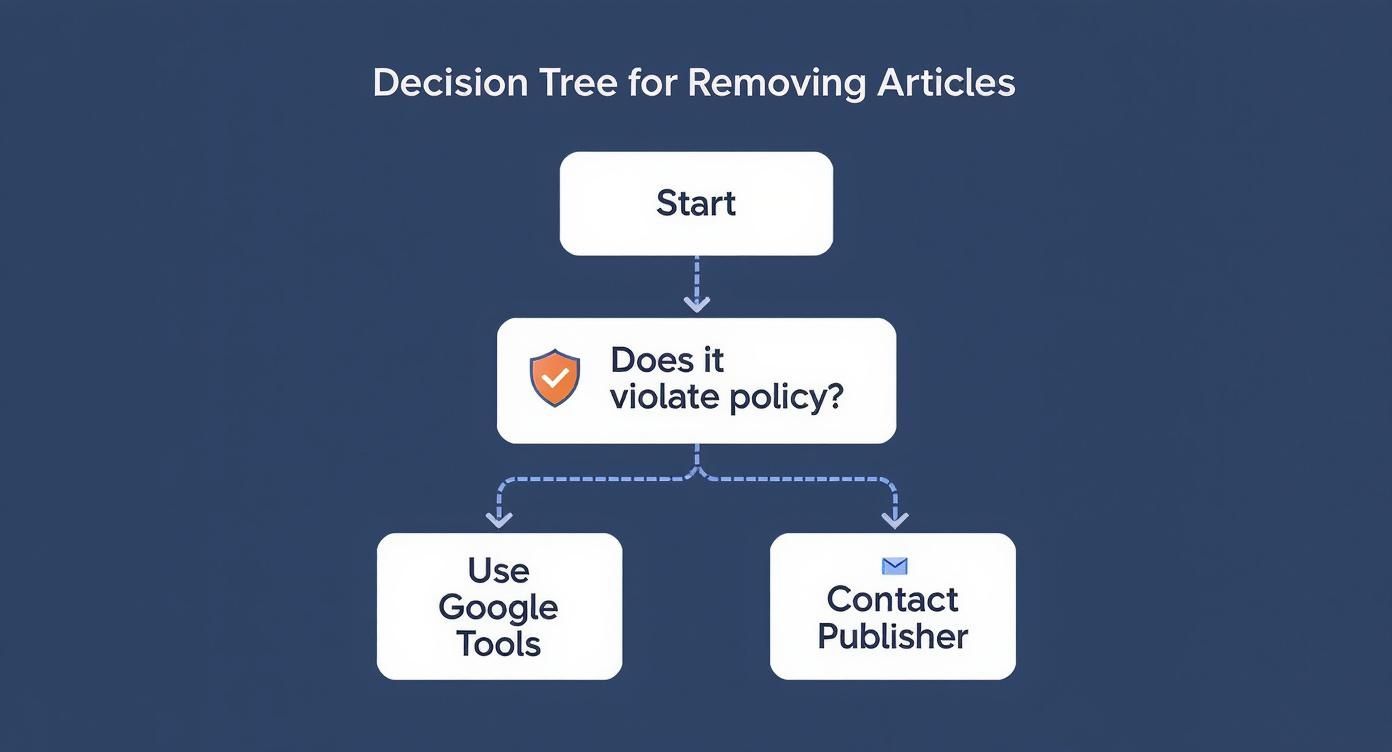
When a damaging article pops up in Google search results, the first thing to understand is a crucial distinction: you're not trying to delete it from the entire internet. Your goal is to get it removed from Google's search index. The most direct and permanent way to do this is by getting the original publisher to take it down.
Your First Move in Google Content Removal
It's a gut-punch, seeing something negative or false about yourself or your business ranking high on Google. The immediate impulse is to go straight to Google and demand they fix it. But here's a piece of advice from years of experience: that's usually not the best first step.
The real power to make that article disappear for good lies with the website that published it. If you can get them to remove it, the problem is solved—not just on Google, but on Bing, DuckDuckGo, and every other search engine.
Before you fire off a single email, you need to stop and analyze the situation. This isn't just a preliminary step; it's the foundation of your entire removal strategy. Getting this right from the start dramatically increases your odds of success. Let's break down what you need to look at.
Evaluate the Content Type
Not all online content is the same. The type of article you're up against completely changes the game plan. A sloppy blog post from an unknown author is a very different beast than an investigative piece from a major news organization that has a team of lawyers on retainer.
Think about where the article falls:
- News Media: These are the toughest nuts to crack. Articles from well-known newspapers or media outlets are heavily protected by journalistic standards and legal precedent. Removal is rare.
- Blogs and Forums: This is often your best-case scenario. Content on smaller, independent blogs or community forums can be much easier to tackle. The publishers are typically more accessible and might not have iron-clad editorial rules.
- Public Records Sites: Mugshot aggregators and data brokers are a different category entirely. They often have established removal processes, but they can be bureaucratic and sometimes require a fee.
- Review Platforms: A bad review on Yelp or Google Maps follows a unique set of platform-specific rules. Your approach here will be completely different from dealing with a news article.
This decision tree gives you a visual on the two main roads you can take when you're figuring out how to get an article out of Google's search results.

As you can see, everything hinges on one key question: does the content actually violate a specific Google policy? If it does, you have a direct path to use their removal tools. If not, your focus has to be on negotiating with the publisher.
Understand the Publisher's Stance
Once you know what kind of content you're dealing with, it's time to do some reconnaissance on the publisher. Dig around their website. Do they have a "Corrections Policy" or a clear "Contact Us" page? Big news organizations sometimes have a public editor or an ombudsman. Finding and reading these policies is non-negotiable.
A publisher’s willingness to even have a conversation is often the single biggest factor in getting content removed. I’ve seen far more success with requests framed as a polite correction or a simple appeal to fairness than with angry, demanding emails. Your first contact sets the tone for everything that follows.
This initial assessment is your strategic blueprint. It tells you whether you should be preparing for a friendly chat with a blogger or gearing up for a formal, evidence-heavy request to a media outlet's legal department.
To make this clearer, here's a quick rundown of the strategies we'll be covering. Think of it as your roadmap for the journey ahead.
Your Content Removal Playbook at a Glance
| Removal Method | Best For | Success Likelihood | Key Action |
|---|---|---|---|
| Publisher Outreach | Factually inaccurate articles, minor blogs, outdated information where the publisher is reasonable. | Moderate | Politely contact the author or editor with clear evidence and a specific request. |
| Google's Outdated Content Tool | Content that has already been removed or changed by the publisher but still appears in search results. | High | Submit a request to update Google’s cached version of the page. |
| Privacy/PII Removal | Doxxing, bank account numbers, explicit non-consensual images, or other sensitive personal information. | High | File a formal removal request under Google’s specific Personal Information policies. |
| Legal Removal (Defamation/DMCA) | Libel, slander, or clear copyright infringement that has been validated by a court order or legal notice. | High (with legal proof) | Submit a legal request through Google's dedicated portal with supporting documentation. |
| The "Right to be Forgotten" | For EU/UK citizens, removing "inadequate, irrelevant, or no longer relevant" personal data. | Moderate | File a request under GDPR, demonstrating why the information is no longer in the public interest. |
This table provides a high-level overview, but success always comes down to the details of your specific situation and how well you execute the chosen strategy.
Building Your Case to Get an Article Removed
A successful removal request is never just a quick email—it's a carefully built case. Before you even think about hitting send, you have to switch hats. Stop thinking like a victim and start thinking like an investigator. Your entire goal is to gather undeniable proof and build an argument so logical and clear that a busy editor or legal department finds it easier to say "yes" than "no."
This prep work is honestly what makes or breaks a request. It’s the difference between an email that gets results and one that’s instantly deleted. It takes a methodical approach, and it all starts with figuring out who actually has the power to take the content down.
Finding the Right Person to Contact
First things first, you need to pinpoint the publisher and, more importantly, the right human being to talk to. Firing off a request to a generic info@ email is almost always a waste of your time. You’re looking for the managing editor, the author of the piece, or maybe a public editor if the publication is large enough to have one.
Here are a few practical ways I track down the right contact:
- Start with the Obvious: Check the website's 'About Us' or 'Contact' page. It sounds simple, but you'd be surprised how often a key name or role is listed right there.
- Use LinkedIn: This is a fantastic tool for this. Search for the publication's name and then filter the employees by titles like "Editor," "Managing Editor," or "Head of Content."
- Go to the Source: If the article has an author byline, that person is often your best first stop. A quick search might turn up their personal website or social media profile with direct contact info.
Once you have a name, your next move is to understand the publisher’s own rules. Scour their website for pages like "Corrections Policy," "Editorial Standards," or "Terms of Service." These documents are your playbook; they tell you exactly what the publisher considers a valid reason for changing or removing something.
Nailing Down the Exact Problem
With your contact in mind, you need to get crystal clear on the type of problem you're dealing with. The kind of harm the article is causing will dictate every other part of your strategy, from the evidence you gather to the argument you make.
Is the content just old and out of date, or is it flat-out defamatory? Does it leak private information, or is it stealing your copyrighted photo? Each of these situations requires a completely different approach and a unique set of proofs.
Your request lives or dies based on proving a specific type of harm. A vague complaint like, "this article is hurting my reputation," is incredibly easy for an editor to ignore. But a documented claim like, "this article contains three factually incorrect statements that have caused direct financial loss, and here's the proof," is much, much harder to dismiss.
Think about which of these buckets your situation falls into:
- Defamation: The content includes false statements of fact (not just someone's opinion) that have tangibly damaged your reputation.
- Privacy Violation: The article exposes sensitive personal information like your home address, private phone number, or financial details without your permission.
- Copyright Infringement (DMCA): The publisher used your original photos, videos, or written work without your consent.
- Outdated Information: The information might have been true at one point, but it’s now misleading because of new events (e.g., charges were dropped, a lawsuit was settled in your favor).
Your Evidence-Gathering Checklist
Alright, it’s time to assemble your evidence file. This isn't the time to be messy. Your documentation needs to be organized, clear, and absolutely convincing.
For Defamation Claims:
Here, the burden of proof is on you to show that specific statements are false and that they caused you real harm. This can be the trickiest to prove, but it's essential. For a deeper dive, our guide on how to prove defamation walks through the specific legal standards.
- Get screenshots of the exact false statements within the article.
- Gather official documents that directly prove the statements are false. Think court records showing dismissed charges, official company press releases, or even emails that establish a different set of facts.
- Document any real-world harm. Have you lost clients? Can you point to harassing messages that directly reference the article? Save it all.
For Privacy Violations:
Your goal is to demonstrate that the information is highly sensitive and its publication serves no real public interest.
- Take crystal-clear screenshots showing exactly where your private data is exposed.
- Find the publisher’s own privacy policy. If they are violating their own rules, point it out directly.
- Clearly explain why the information is sensitive and how its publication puts you or your family at risk.
This diligent, evidence-first approach is what elevates your request from a simple complaint into a professional, well-supported appeal that publishers have to take seriously.
Reaching Out to Website Publishers

When you’re trying to figure out how to remove Google articles, your most powerful move is often the most direct one: contacting the website owner or publisher. It can feel a little intimidating, but a single, well-written email sent to the right person can accomplish what no automated tool can—getting the source content taken down for good.
This isn't just about firing off an email, though. Think of it as opening a negotiation. Your tone, the proof you provide, and how clearly you state your case will make the difference between a successful removal and being completely ignored.
Finding the Right Person is Half the Battle
The fastest way to get your request ignored is to send it to a generic info@ or contact@ email. Those inboxes are often black holes, flooded with spam and rarely checked by anyone with the power to help you. Your mission is to find the person who can actually make a decision.
Start by zeroing in on specific roles within the organization:
- The Author: If the article has a byline, the writer is a fantastic place to start. They have a personal stake in their work and might be more open to a polite, direct conversation.
- The Managing Editor: In larger outfits, this is the person who oversees all editorial content. They have the authority to greenlight corrections, updates, and even full-on removals.
- A Public Editor or Ombudsman: Some major news organizations have this role specifically to handle reader complaints and ethical issues. It’s a formal and often very effective route.
Use tools like LinkedIn to find people with these titles at the publication. A personal email address is always better than a generic one. Getting your message in front of the right individual dramatically increases your chances of it being read and taken seriously.
How to Structure Your Removal Request for Success
Once you have a contact, it's time to write the email. The key is to be professional, clear, and persuasive. Any hint of anger, emotion, or demands will almost certainly get your message deleted on sight.
Frame your request as if you're helping them maintain accuracy or fairness, not as a demand. You're appealing to their sense of journalistic integrity.
You often only get one chance to make your case. Editors are busy. A sloppy, unconvincing, or aggressive email makes it incredibly easy for them to say no. A professional request backed by solid proof forces them to take you seriously.
A solid email has a few key ingredients. Each part works to build your argument and guide the editor toward taking the action you want.
The Anatomy of an Effective Outreach Email
Your email needs to be short enough to be read but detailed enough to be convincing. A logical structure makes your case easy for a busy person to follow.
A Clear, Professional Subject Line: This is your first impression. Vague subjects like "Question" or "Urgent" are useless. Be specific. Try "Request for Correction Regarding Article: [Article Title]" or "Factual Inaccuracy in [Article Title]."
A Polite Introduction: Get straight to the point. Briefly introduce yourself and state why you're writing. Include the full article title and its URL right at the top so they don't have to hunt for it.
The Core Argument—Backed by Evidence: Here’s where you make your case. Calmly and clearly explain why the content is problematic. Lay out the facts and attach the proof you gathered earlier.
A Specific, Actionable "Ask": Don't just complain—tell them exactly what you want. Do you need the entire article taken down? Your name removed? A specific sentence corrected? Be explicit about the ideal outcome.
A Professional Closing: Thank them for their time and consideration. End with your contact information and let them know you’re happy to provide more details if needed.
This structured approach changes your message from a complaint into a professional communication, which is far more likely to get a real response. Keep in mind the sheer scale of this world; in 2023 alone, Google removed 5.5 billion ads and took policy action on 2.1 billion publisher pages. As you can see from Keywordseverywhere.com's summary of Google's efforts, publishers are dealing with these issues constantly. A professional, well-supported request is your best bet for cutting through that noise.
What to Do When the Publisher Won’t Cooperate: Using Google’s Tools

So, you’ve sent your emails, made your case, and the publisher has either ignored you or flat-out refused to help. It’s a frustrating spot to be in, but it’s not the end of the road. This is the point where you stop trying to persuade and start following a process. Google has several powerful—if highly specific—tools that let you go over the publisher’s head and request removal directly from their search results.
Let’s be crystal clear about one thing: these tools do not take the article off the original website. They only remove the URL from Google’s search index. This makes it incredibly difficult for most people to find, but it doesn't erase the page itself. It's an important distinction, but for most people, making something invisible on the world's biggest search engine is a huge win.
Let's walk through the most practical options Google gives you.
Start with the "Results About You" Tool for Privacy Issues
Google's "Results About You" dashboard is your first and best stop if the problem involves your personal identifying information (PII). This tool was specifically designed to help people regain control when sensitive data like a home address, phone number, or private email address gets posted online.
Instead of wrestling with complicated legal forms, this dashboard lets you quickly flag URLs that contain your PII. It's a much more user-friendly approach.

As you can see, Google’s policy is pretty comprehensive. It covers everything from government ID numbers to explicit personal photos. If the article you’re targeting contains any of this information, the "Results About You" tool is the most direct path you can take.
I've seen a lot of people think this tool is a magic wand for any content they don't like. It's not. Google is looking for specific criteria, like 'doxxing' or a real risk of identity theft or harm. Just because an article is unflattering won't be enough to get it removed under this policy.
This tool is a big step forward for online privacy. Recent updates have even expanded its capabilities, but it has its limits. Even when Google delists a URL, the page still exists and can be found in other ways. If you want to set realistic expectations, you can explore more about these tests and the tool's effectiveness to see how it performs in the real world.
Escalate to Legal Removal Requests
When you’re dealing with something more serious than a privacy leak, you’ll need to move on to Google’s legal removal tools. These are formal, structured processes reserved for clear violations of the law, and they require solid documentation to back up your claim.
These requests are reviewed by Google’s legal team, so they aren’t taken lightly. You have to build a strong case.
Defamation (Libel or Slander): Is the article full of false statements of fact that have hurt your reputation? You can file a defamation complaint. But this is a very high bar. In nearly every case, Google will require a court order officially declaring the content defamatory. Your personal belief that it's defamatory, no matter how strong, isn't enough.
Copyright Infringement (DMCA): Did a website publish your original photo, article, or video without permission? This is what a Digital Millennium Copyright Act (DMCA) takedown notice is for. It's a formal legal request where you assert ownership of the content and demand its removal.
The "Right to be Forgotten": This is a powerful legal framework, but it’s geographically limited. For citizens in the EU, UK, and a few other places, it allows you to request the removal of search results that are "inadequate, irrelevant or no longer relevant." It's most often used for old, outdated information that no longer serves the public interest.
How to Navigate the Removal Process
No matter which tool you end up using, the basic steps are the same. You need to be prepared with the right information to get your request handled efficiently.
- Get Your URLs: You need two things: the exact URL of the web page with the problem content and the URL of the Google search result you want gone.
- State Your Case: Be direct. Clearly explain why the content violates a specific policy or law. Don't just complain; reference the rule. For example, "This page contains my private home address, which violates the PII policy."
- Bring the Proof: For legal requests, this is absolutely essential. You'll need to attach the court order for a defamation claim or provide evidence of your copyright ownership for a DMCA notice.
Once you submit, be prepared to wait. Google handles millions of these requests. A straightforward PII violation might get a response in a few days, but a complex legal issue could take weeks or even months. You can track the status of your requests through your Google dashboard.
These tools aren't a silver bullet for every online reputation problem, but they are a crucial lifeline when publishers won't cooperate. If you find yourself in a more complex situation, it might be time to bring in professionals. You can learn more about how to remove Google articles with expert help over on our services page: https://levelfield.io/content-removal/google
When It’s Time to Hire a Reputation Management Pro
Sometimes, trying to remove a negative Google result on your own feels like fighting a losing battle. You’ve sent the polite emails, you’ve filed the forms with Google, and yet, that damaging article is still the first thing people see when they search your name. This is usually the point where the DIY approach hits a wall.
It's the moment you need to seriously consider bringing in a professional.
Knowing when to make that call is half the battle. Certain situations are incredibly tough for an individual to navigate but are just another Tuesday for a seasoned online reputation management (ORM) firm. Recognizing these red flags can save you months of spinning your wheels and stop a bad situation from getting worse.
Signs You Need to Call an Expert
If you’re up against a high-authority news site, you're in for a fight. Think major media outlets with their own legal teams and rigid editorial policies. An email from an individual asking for a takedown usually gets ignored or flat-out rejected. Professionals, on the other hand, have established contacts and know how to frame a request in a way that editors will actually consider. They can often negotiate solutions like de-indexing or anonymizing the content when a full removal isn't on the table.
Another clear sign is when you're facing a widespread, coordinated attack. This isn't just one bad article. It's a storm of negativity—a cluster of negative posts, fake reviews, slander on forums, and toxic social media comments. This kind of campaign is often the work of a malicious competitor or a single-minded detractor. It requires a multi-front strategy that a few simple removal requests won't solve.
A lot of people underestimate what a true reputation crisis looks like. When one negative article gets syndicated across dozens of smaller sites or becomes part of a negative SEO attack, you’re not just putting out a small fire—you’re facing a wildfire. A professional service has the tools and people to tackle that kind of problem at scale.
Finally, if the issue requires legal action, it’s time to stop guessing. Getting a court order for defamation is a complex legal maze. A reputable ORM firm, often working alongside legal counsel, knows exactly what evidence is needed and which procedures to follow to force a publisher—or Google—to comply.
What a Reputation Management Firm Actually Does
Hiring a professional isn't just about paying someone to send a sterner-sounding email. These firms bring a whole toolbox of strategies to the table that most people don't even know exist. Their work generally falls into two main buckets.
First is direct removal and negotiation. They use their experience and industry contacts to get the damaging content taken down permanently. They know who to call, what to say, and how to package the evidence to make the strongest possible case. Their requests simply carry more weight because publishers know they’re dealing with professionals who understand the legal landscape.
Second, and often more crucial, is content suppression. When an article simply cannot be removed, the strategy shifts to burying it. This involves creating and promoting a wave of high-quality, positive content—things like professional bios, positive news features, press releases, and fully optimized social media profiles. Using advanced SEO tactics, they push this positive content up in the search rankings until the negative article is pushed down to page two or three of Google, where almost no one will ever see it.
For cases that involve complex legal work, it helps to understand the nuances of legal process outsourcing to see how professionals efficiently manage these critical steps.
Choosing the Right Reputation Partner
The online reputation industry has its share of shady operators, so doing your homework is essential. Be extremely wary of any company that guarantees removal—no one can honestly promise that. A trustworthy firm will be transparent about its methods and give you a realistic assessment of your chances.
Before you sign any contracts, make sure you ask these questions:
- Can you share some anonymized case studies of situations like mine?
- What specific strategies will you use for my case—are we aiming for removal or suppression?
- How do you report on progress, and what metrics do you use to define success?
- What does your fee structure look like? (Pro-tip: avoid "pay-for-removal" models, as they can encourage minimal effort.)
Hiring a pro is an investment in taking back control of your story. When you feel outmatched, bringing in an expert team is the smartest move you can make.
Common Questions About Removing Articles From Google
When you're trying to get a damaging article taken down, you're bound to have questions. The process can feel confusing, and knowing what to expect is half the battle. Let's walk through some of the most common issues people run into.
How Long Does It Actually Take to Get an Article Removed?
This is the million-dollar question, and the honest answer is: it depends entirely on your removal method. There’s no magic number.
Your fastest route is always getting the publisher to cooperate. If you can convince them to delete the page, you might see it vanish from Google search in just a few days to a week. Google's web crawlers will eventually revisit the page, see it's gone (a 404 error), and drop it from their index.
But if the publisher ghosts you or flat-out refuses, you're left with Google's tools, and that's when the clock starts ticking much slower. Using the "Outdated Content Removal" tool for a page that's been changed might take a few weeks. If you're filing a more serious legal request for something like defamation or a copyright violation, you could be waiting several weeks or even months for Google’s legal team to complete their review.
The quickest win is always direct cooperation from the publisher. Google's processes are a necessary fallback, but they come with review queues and strict guidelines that naturally draw things out. Patience is non-negotiable here.
If I Get an Article Removed from Google, Is It Gone from Bing, Too?
Unfortunately, no. Any removal action you take with Google is siloed within its own universe. When Google de-indexes a page, it only disappears from Google search results. It will have zero effect on its ranking or visibility on other search engines like Bing, Yahoo, or DuckDuckGo.
The article will still be live and searchable on those other platforms. To get it removed there, you'd have to go through each of their own specific removal procedures, which are often less straightforward than Google's.
The only way to make an article disappear from every search engine at once is to get the publisher to permanently delete the original URL. Once the source page is gone, all search engines will eventually catch on and remove it from their results. This is the main reason why we always say publisher outreach is the most thorough solution.
What if the Article Is True but Still Ruining My Reputation?
This is, without a doubt, the toughest situation to be in. When an article is factually accurate, particularly if it was published by a legitimate news outlet, your removal options shrink dramatically.
In most Western countries, principles like freedom of the press give publishers the right to report on factual events, even if the story is deeply damaging to someone's reputation. A news organization has no legal duty to un-publish a true story just because you don't like it. You can't claim defamation, because the foundation of any defamation case is proving the information is false.
When removal isn't on the table, the strategy shifts from erasure to suppression. It’s a proactive approach focused on controlling what people see first.
- Build Your Own Narrative: Start by creating positive, high-quality content that you control. Think personal websites, professional blogs, or a really well-optimized LinkedIn profile.
- Boost Your Positive Assets: Apply SEO strategies to these new assets so they start climbing the search rankings for your name. The entire goal is to dominate the first page of Google with content that paints you in a positive light.
- Bury the Negative: As your positive content rises, the harmful article is pushed down—ideally to the second or third page of search results, where fewer than 1% of people will ever see it.
Suppression isn't a quick fix; it's a long-term reputation management strategy. It’s about taking back control of your online story when you can't erase the past.
